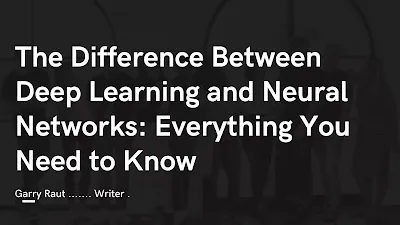The Difference Between Deep Learning and Neural Networks: Everything You Need to Know
What is Deep Learning?
If you haven’t heard of deep learning, I highly recommend that you have a look at this awesome definition by Deep Learning (also called Deep Learning) is a specific approach to machine learning in computer science, especially in the field of artificial intelligence. In short, it consists of a set of computational methods for designing and simulating artificial neural networks and for training these neural networks to make decisions in the same way that the brain does. Deep learning is a branch of machine learning that has emerged in recent years. It’s most important mathematical concepts are the Long Short Term Memory (LSTM) and Long Short Term Memory (LSTM) networks, which can store and recover information through tiny discrete steps.
What is Neural Networks?
Neural Networks is a mathematical model which has been first implemented by a Russian-American physicist and engineer Ivan Sutherland (1924-2000). Neurons are tiny clusters of interconnected neurons that fire together. These connections allow a group of neurons to form a system of connection, in which it can solve a problem. What is Deep Learning? Deep Learning is a type of Artificial Neural Networks. In Deep Learning, multiple layers of Deep Neural Networks, called Deep Neural Networks (DNNs) are combined to form a Multiple Neural Network which can solve large scale and complex problems. What is the Difference Between Neural Networks and Deep Learning? Neural Networks were not only designed to solve small scale tasks, but also solve large-scale ones as well.
What is the Difference Between Deep Learning and Neural Networks?
Deep learning is an AI technology which is highly related to the Neural Networks (a.k.a. deep neural networks). Neural Networks are computational models for one or more layers of processing, which can be capable of learning from experience. They can be comprised of layers of artificial neurons each with many inputs and outputs, all connected together in series, and that form a recurrent structure. In deep learning, the algorithm learns not from a single supervised example, but from a single example, often through the use of clusters of examples or "neural networks." What is deep learning, and why is it relevant to speech recognition? Deep learning is used in many applications including image, speech, and computer vision.
Where is Deep Learning Used?
Applications of deep learning include speech, image, and video processing. Deep learning is important for automotive and health-related applications such as self-driving cars and smart cancer diagnosis systems. It is also used in applications such as facial recognition, voice recognition, image processing, natural language processing and electronic medical record search. Applications of Deep Learning Still Vulnerable While deep learning has been used for data mining, market forecasting, and statistics, its widespread adoption is in the final stage of development. But some other applications of deep learning are just as vulnerable to possible backdoors.
Why is Deep Learning Important?
If you are a developer or are looking to build new features to your application then you will definitely need a deep learning algorithm. The deep learning algorithm has a huge impact on the developer's workflow because the deep learning algorithms are difficult to create. For example, if you want to create an artificial intelligence (AI) you need to integrate the deep learning algorithms. You may also want to increase your system's intelligence. You can improve your system by using a deep learning algorithm. That is why the deep learning algorithm is important. When you decide to use a deep learning algorithm then you need to be aware of the following differences: One of the most important is the possibility to implement a deep learning algorithm with just a laptop.
Conclusion
Learning in deep learning can be done in a hierarchical manner. The hardware is the foundation, but the program can further be written to learn higher levels. We will discuss different techniques such as Stochastic Recurrent Unit (SRU), Autoencoders and Deep Belief Networks, also Spatial regularized Temporal Filtering (SGD), LSTM, etc. while building a simple random forest classifier. We will also have a deeper look into the relationship between long short term memory (LSTM) and Deep Learning.
